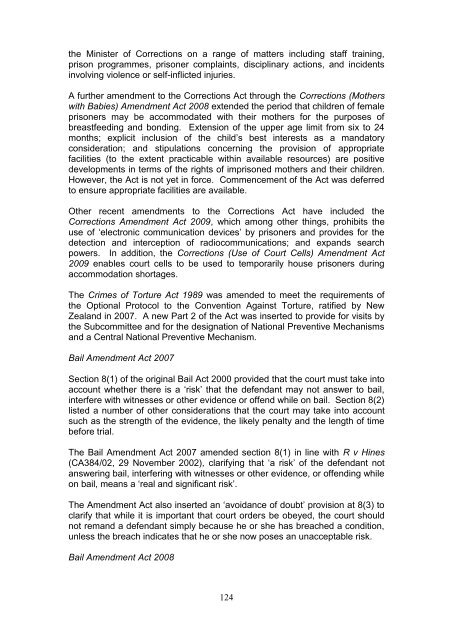Human Rights and Prisons - Rethinking Crime and Punishment
Human Rights and Prisons - Rethinking Crime and Punishment
Human Rights and Prisons - Rethinking Crime and Punishment
You also want an ePaper? Increase the reach of your titles
YUMPU automatically turns print PDFs into web optimized ePapers that Google loves.
the Minister of Corrections on a range of matters including staff training,<br />
prison programmes, prisoner complaints, disciplinary actions, <strong>and</strong> incidents<br />
involving violence or self-inflicted injuries.<br />
A further amendment to the Corrections Act through the Corrections (Mothers<br />
with Babies) Amendment Act 2008 extended the period that children of female<br />
prisoners may be accommodated with their mothers for the purposes of<br />
breastfeeding <strong>and</strong> bonding. Extension of the upper age limit from six to 24<br />
months; explicit inclusion of the child‟s best interests as a m<strong>and</strong>atory<br />
consideration; <strong>and</strong> stipulations concerning the provision of appropriate<br />
facilities (to the extent practicable within available resources) are positive<br />
developments in terms of the rights of imprisoned mothers <strong>and</strong> their children.<br />
However, the Act is not yet in force. Commencement of the Act was deferred<br />
to ensure appropriate facilities are available.<br />
Other recent amendments to the Corrections Act have included the<br />
Corrections Amendment Act 2009, which among other things, prohibits the<br />
use of „electronic communication devices‟ by prisoners <strong>and</strong> provides for the<br />
detection <strong>and</strong> interception of radiocommunications; <strong>and</strong> exp<strong>and</strong>s search<br />
powers. In addition, the Corrections (Use of Court Cells) Amendment Act<br />
2009 enables court cells to be used to temporarily house prisoners during<br />
accommodation shortages.<br />
The <strong>Crime</strong>s of Torture Act 1989 was amended to meet the requirements of<br />
the Optional Protocol to the Convention Against Torture, ratified by New<br />
Zeal<strong>and</strong> in 2007. A new Part 2 of the Act was inserted to provide for visits by<br />
the Subcommittee <strong>and</strong> for the designation of National Preventive Mechanisms<br />
<strong>and</strong> a Central National Preventive Mechanism.<br />
Bail Amendment Act 2007<br />
Section 8(1) of the original Bail Act 2000 provided that the court must take into<br />
account whether there is a „risk‟ that the defendant may not answer to bail,<br />
interfere with witnesses or other evidence or offend while on bail. Section 8(2)<br />
listed a number of other considerations that the court may take into account<br />
such as the strength of the evidence, the likely penalty <strong>and</strong> the length of time<br />
before trial.<br />
The Bail Amendment Act 2007 amended section 8(1) in line with R v Hines<br />
(CA384/02, 29 November 2002), clarifying that „a risk‟ of the defendant not<br />
answering bail, interfering with witnesses or other evidence, or offending while<br />
on bail, means a „real <strong>and</strong> significant risk‟.<br />
The Amendment Act also inserted an „avoidance of doubt‟ provision at 8(3) to<br />
clarify that while it is important that court orders be obeyed, the court should<br />
not rem<strong>and</strong> a defendant simply because he or she has breached a condition,<br />
unless the breach indicates that he or she now poses an unacceptable risk.<br />
Bail Amendment Act 2008<br />
124
















